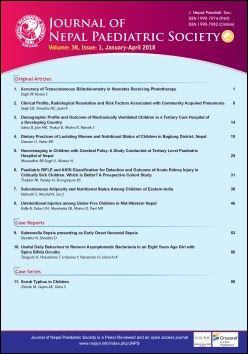Clinical Profile, Radiological Resolution and Risk Factors Associated with Community Acquired Pneumonia
DOI:
https://doi.org/10.3126/jnps.v38i1.18854Keywords:
community acquired pneumonia, chest radiographyAbstract
Introduction
Pneumonia is a widespread and commonest infectious lung disease that causes inflammation which lead to reduced oxygenation. Indeed, it is the leading cause of child death in the world. The study was carried out to fine out the demographic, clinical characteristics and radiologic resolution of Pneumonia in children between 2 months to 16 years of age.
Material and Methods
A prospective study done in 121 cases over 18 month period in patients admitted in pediatric department of Dhulikhel hospital. Demography, clinical profile, diagnosis, Down’s scoring at presentation, response of treatment and risk factor for fetal Community acquired pneumonia were analyzed using descriptive statics. Chest radiography was done on admission and every 2 weeks until its complete resolution occurred.
Results
A total of 121 patients with community acquired pneumonia were enrolled. The male and female ratio was 1.69:1. Among all age group it was most significantly common in children less than 1 year (p=.022).The common symptoms of Community acquired pneumonia observed in this study were cough (80%), fever (66%) and shortness of breath (38.8%). On chest roentgenogram right middle zone(47.9%) was most frequently involved. The total leukocyte count had low degree of association with pneumonia. More than half of patients (54.08%) with community acquired pneumonia had radiographic resolution at 2 weeks. The respiratory distress was significantly high (p<0.0001) in children who delayed to seek medical treatment in a health facility by three days.Anemia, lymphopenia, thrombocytopenia, sepsis and hemorrhagic pleural effusion were the clinical characteristics associated withfatal Community acquired pneumonia
Conclusion
Clinical presentations variesin Community acquired pneumonia with different age groups. Chest radiography is still best investigation for the diagnosis of pneumonia and most of the radiological clearance occurs in 2 weeks.
Downloads
Downloads
Additional Files
Published
How to Cite
Issue
Section
License
Authors who publish with this journal agree to the following terms:
Authors retain copyright and grant the journal right of first publication with the work simultaneously licensed under a Creative Commons Attribution License that allows others to share the work with an acknowledgement of the work's authorship and initial publication in this journal.
Authors are able to enter into separate, additional contractual arrangements for the non-exclusive distribution of the journal's published version of the work (e.g., post it to an institutional repository or publish it in a book), with an acknowledgement of its initial publication in this journal.
Authors are permitted and encouraged to post their work online (e.g., in institutional repositories or on their website) prior to and during the submission process, as it can lead to productive exchanges, as well as earlier and greater citation of published work (See The Effect of Open Access).



